Twelve tribes of Israel
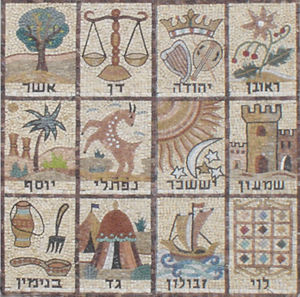
The story of the twelve tribes of Israel is usually thought to have begun with Abraham, the progenitor and first patriarch of the Hebrew people. But, in reality, their record on earth begins much earlier, with the coming of Sanat Kumara, the Ancient of Days. He came on a rescue mission at the time that was the lowest and darkest moment in earth’s history.
The Cosmic Council that governs the destiny of the earth decreed the dissolution of the planet and her evolutions because every single person on earth had forgotten the Source and the threefold flame.
At that time, Sanat Kumara, the hierarch of Venus, came before the Cosmic Council and said, “I will volunteer to be the saviour of the earth. I will volunteer to keep the flame of the earth until some among mankind awaken to the knowledge of the Law.” Sanat Kumara was granted the opportunity to come to earth to keep the flame.
The incarnation of the lightbearers
When the lightbearers of Venus, Mercury and other planetary homes heard that he was volunteering to stand for the evolutions of earth, they volunteered to go with him and were accepted. And thus, when Sanat Kumara came to earth, there was a retinue of lightbearers who came with him to establish Shamballa, his retreat on the White Island in the Gobi Sea (which is now the Gobi Desert in China).
Those who came with Sanat Kumara were to embody according to a prearranged destiny among the nations of the earth. Their mission was to be the lightbearers who would teach mankind the way of the Trinity, the way of the threefold flame, the way of the sacred fire, and remind them of their origin. They would come, then, to the East and to the West, and they would come to teach mankind the way of the Father and the way of the Mother.
In the West, the lightbearers who incarnate to serve the light are known as the twelve tribes of Israel. In the East, they form the mystery schools that are in the tradition of the Guru and the chela. In each instance, this body of souls is intended to pass on, generation to generation in an unbroken chain all the way from Lemuria, the true teachings of the religion of the Father and the religion of the Mother.

The twelve tribes: seed of Sanat Kumara and Abraham
In the West, the evolution of the twelve tribes under the Judeo-Christian tradition has been a history of disobedience and chastisement and then redemption. Recorded in the Old Testament, there is history of the judgment of the people of Israel delivered over and over again through laggard evolutions.
The quest in the West has centered around finding grace in the sight of God through the finding of the Christ, the Mediator, and through becoming the friend of God, as Abraham was a friend of God through that Christ.[1] This path is fulfilled in the person of Jesus Christ.
The recorded history of these lightbearers in the West, the twelve tribes of Israel, begins in the Bible, in Genesis, chapter 12, when God promises to bless Abraham: “I will make of thee a great nation, and I will bless thee, and make thy name great; and thou shalt be a blessing.”[2]
In chapter 15 God says to Abraham (when he was still known as Abram): “Look now toward heaven, and tell the stars, if thou be able to number them: and he said unto him, So shall thy seed be.”[3] God then told Abraham to make a sacrifice. He did so, and God told him of a karma that would come upon his seed:
And when the sun was going down, a deep sleep fell upon Abram; and, lo, an horror of great darkness fell upon him. And [the LORD] said unto Abram, Know of a surety that thy seed shall be a stranger in a land that is not theirs, and shall serve them; and they shall afflict them four hundred years; and also that nation, whom they shall serve, will I judge: and afterward shall they come out with great substance. [This is a prophecy of the captivity of the twelve tribes in Egypt.]
And thou shalt go to thy fathers in peace; thou shalt be buried in a good old age. But in the fourth generation they shall come hither again: for the iniquity of the Amorites is not yet full.[4]
Sanat Kumara chose Abraham to be the father of the Israelites, to be the one who would receive in his old age, through Sarah, the son Isaac. Isaac would then have the son Jacob; Jacob would give birth to twelve sons, who would become the progenitors of the twelve tribes.
Thus, Abraham is the great patriarch of the lightbearers, chosen to bear the seed of Alpha. These souls came with a specific mission to be a witness unto the true God in the midst of idolatry, in the midst of the great darkness of the Middle East, such as that seen at Sodom and Gomorrah. They came to illustrate the blessedness of serving God, to receive and preserve the prophecy and the revelations, and above all, to be the channel through whom the Messiah would be born.

The twelve sons of Jacob
In approximately 1900 B.C. God conferred his blessing on Isaac, Abraham’s son: “And the LORD appeared unto him the same night and said, I AM the God of Abraham thy father: fear not, for I am with thee, and will bless thee, and multiply thy seed for my servant Abraham’s sake.”[5] It is very interesting that the LORD blesses each generation of lightbearers, signifying that the blessing is not automatic by a transference of heredity, but comes by the reinstatement of the blessing for each generation.
Isaac’s son Jacob received the LORD’s blessing in his turn many years later and another blessing when he wrestled with the angel, Archangel Michael, who purged him of his evil and thereby allowed him to receive the anointing of the name “Israel.”[6]
Jacob had twelve sons, born of his four wives. They were anointed by Sanat Kumara to carry the seed of light for the ultimate fulfillment of the destiny of the lightbearers. His favorite son was the eleventh, Joseph, for whom he made the coat of many colors. This coat is the symbol of the causal body of the children of Israel. He chose Joseph to wear this coat because he saw that Joseph had the greatest manifestation of the Christ consciousness and could carry the flame of the blending of all of the color rays of the causal body. So, Joseph received his birthright from his father, Israel.
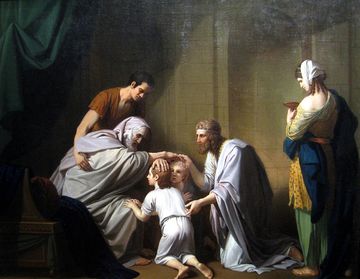
But Joseph’s brothers were jealous of him. They first plotted to kill him, but decided instead to sell him into slavery. Joseph was taken to Egypt, where he gained the confidence of the Pharaoh and became second in command. When drought and famine besieged the land, Jacob and his eleven sons came to Egypt to find food. Joseph revealed himself to them, and the family was reunited. Once again the twelve brothers became united as one mandala. As a token of his love for Joseph, Jacob took Joseph’s two sons, Manasseh and Ephraim, for his own.
The names of the twelve sons of Jacob are Reuben, Simeon, Levi, Judah, Issachar, Zebulun, Joseph, Gad, Asher, Dan, Naphtali and Benjamin. The descendents of each son became the twelve tribes, and each tribe took the name of its patriarch. In earlier lists Joseph is named as one of the tribes. In later lists, Levi is omitted and Joseph is replaced by his sons, Ephraim and Manasseh. Levi thus became the thirteenth tribe, the one in the center of the circle holding the office of Christ and the flame of the priesthood.
Prior to his death, Jacob gave his final blessing to his twelve sons, and he gave his prophecy of the tribes and their destiny. It is recorded in Genesis, chapter 49.
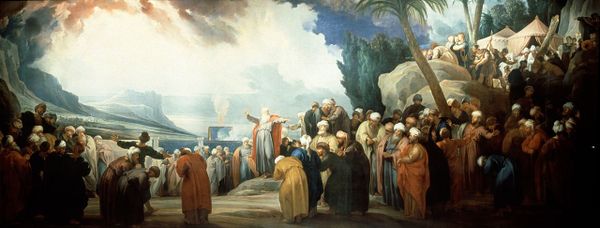
Admonishment and blessing of the twelve tribes
After many years, the descendants of Jacob’s sons living in Egypt multiplied to such a degree that the Pharaoh felt threatened by their numbers and might. He enslaved them and ordered all newborn Hebrew males to be drowned at birth.
Moses was born during this perilous time, but his mother saved his life by setting him afloat in a basket on the Nile. Pharaoh’s daughter found him and raised him as her own son. In answer to a call from God, Moses led his people out of Egypt toward the Promised Land. After forty years of wandering in the wilderness, the Hebrews, under the leadership of Joshua, entered and conquered the Promised Land, the land of Canaan.
Before his parting, Moses gives a blessing and an admonishment to these twelve tribes and the passes the torch to his chela, Joshua. In these parting words, Moses rebukes them and prophesies that although he has admonished them to walk uprightly and to choose life and not death, they will backslide, they will become stiff-necked, they will forget his word as soon as he has departed. These words are recorded in the final chapters of Deuteronomy.
Moses warned them against mingling with the neighboring nations, taking up their gods, intermarrying with them. These neighboring nations were the nations of the Nephilim and the fallen ones. And Moses predicted that they would enter into associations with them, walk in their ways and follow their idolatry. He predicted that if they did so, therefore choosing their cult of death, the curses of the LORD would be upon them—meaning that judgment, or karma, would come upon them for their actions.
At the conclusion of the reading is Moses’ blessing of these twelve tribes before his transition. We see the great love of Sanat Kumara through Moses for each of those twelve tribes. Previously there had been the rebuke and the statement of karma and their faults. Yet in this blessing, each one is praised, and there is a prophecy given as to what they will accomplish. These prophecies are veiled and they are based on symbolism. The seal of that blessing gives us the divine plan and the opportunity for victory of each of these twelve tribes, as they each hold one line of the twelve points on our cosmic clock of initiation.
Moses was the Great Guru unto the twelve tribes of Israel. We are living in an hour when all of the promises of God through the prophets for the restoration of the memory of the tribes and the restoration of the Promised Land are about to be fulfilled—prophecies concerning the transmutation of karma couched in the words, “I will remember their sin no more.”[7]
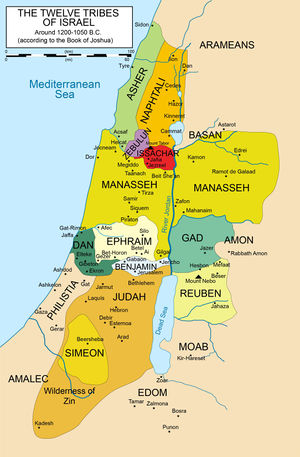
The dispersion
Joshua divided the conquered territory among the tribes according to God’s direction. The only tribe that did not receive territory was the tribe of the Levites. The Levites led the people in worship, were responsible for teaching God’s Law and performed other religious functions. The twelve tribes formed a loosely knit confederacy bonded together by their religious covenant with God. They were each in charge of their own territory, but in time of crisis they banded together to fight a common enemy.
After Joshua passed on, the tribes were led by judges. The judges were primarily charismatic military leaders raised up by God to defend the people against the encroachments of neighboring nations.
During the period of the judges, from about 1200 to 1030 B.C., the Israelites began to worship pagan gods, the gods of materialism, the gods of the fallen angels. God punished them for their idolatry and apostasy by allowing other nations to harass and attack them. These invaders seized their land and crops and exacted tribute from them.
When the Israelites repented and obeyed God’s laws, the LORD empowered the judges to champion their cause, and once again they enjoyed peace. The pattern of disobedience then punishment, repentance then deliverance was repeated over and over again. The leadership of the judges ended when the people demanded of Samuel, the last judge of Israel: “We will have a king over us that we also may be like all the nations.”[8] They believed their tribal confederacy was not strong enough to ward off the growing threat of Philistine armies.
Samuel told the people that their desire for a king was a rejection of God. In fact, it showed a waning of their attunement with the living Presence of God with them and their forgetfulness of God’s continual deliverance as he manifested himself to them through Archangel Michael, Archangel Gabriel and all of the heavenly hosts. And so, they looked for power in a human being, a leader and a king.
Samuel reluctantly consented to their demand by anointing Saul king but warned that a monarchy would bring them oppression. When Saul died, David became king of Israel after a short period during which Saul’s son ruled over the northern tribes. Solomon succeeded his father, David, to the throne, and although he brought prosperity and peace to the land, he also placed a heavy burden on the people through taxation and slavery.
Shortly after Solomon’s death in about 922 B.C., the ten tribes in the North rebelled against Solomon’s son and successor to the throne, Rehoboam. These tribes formed their own kingdom, called Israel, ruled by their own king. The tribes of Judah and Benjamin made up the smaller and poorer Southern Kingdom, called Judah.
For about fifty years following the division of the kingdom, Israel and Judah fought a civil war over border territory. Partly as a result of their squabbles with each other, the two kingdoms lost territory to neighboring nations. In the coming centuries, Israel and Judah became more and more vulnerable because of their backsliding. The prophet Hosea, preaching in the Northern Kingdom, decried the growing social corruption, worship of pagan gods and moral decay. He warned the Israelites that they had broken their sacred covenant with God and would pay the price.
In 721 B.C. the Assyrians under Sargon II conquered the Northern Kingdom of Israel and forcibly deported most of the people to Assyria. This was the end of the Northern Kingdom. Because the fate of the ten northern tribes after they were deported is unknown, they are referred to as the ten lost tribes. It is widely believed that they never again returned to their homeland.
With the demise of the Northern Kingdom, Judah became a vassal of Assyria, and then, in the seventh century B.C., it became a vassal of the Babylonian Empire. During this turbulent time, the prophet Jeremiah preached God’s imminent judgment upon Judah for her sinfulness. He warned that if the people did not turn wholeheartedly to their God, they would meet the same fate as Israel at the hands of an “evil from the north.”[9]
Judah, like Israel, was guilty of idolatry, apostasy, corruption and moral degeneracy. They had erected altars to a host of foreign gods whom they worshiped alongside the LORD. The fertility cult’s sacred prostitution was practiced in the Temple at Jerusalem. Some of the people even took part in the pagan practice of human sacrifice, making “their sons and their daughters to pass through the fire unto Molech.”[10]
The LORD’s prophecy through Jeremiah was fulfilled. The king of Judah rebelled against the Babylonians, and in 597 B.C. the Babylonian king Nebuchadnezzar besieged Jerusalem and deported the king and leading men of Judah.
In 587 B.C., the Babylonians totally destroyed Jerusalem—looting, burning every building including the Temple, and deporting all but a few inhabitants. A third deportation took place in 582 B.C. Although they had been taken from their homeland, the conditions for the exiles were not unfavorable. The Jews became farmers, merchants, traders, soldiers, even government officials, some rising to positions of wealth.
The coming of the Messiah
In 538 B.C. the Persian king Cyrus, conqueror of Babylonia, issued a decree permitting the Jews to return to Jerusalem and rebuild the Temple. Most of them had forgotten and were not concerned with their inheritance; only a small remnant of the tribes returned, most of them from the tribes of Judah and Benjamin. They brought the Temple vessels that had been stripped from them in 587 B.C., and the Temple in Jerusalem was rebuilt.
This was the time of preparation for the coming of the Messiah. As we now understand, the preparation for Jesus’ coming had begun with Sanat Kumara, Abraham, Isaac, Jacob, the twelve sons. But what happened to them?
Living at this particular period in Egypt and in the Fertile Crescent were a conglomeration of peoples. Some of them were Baal worshipers, worshipers of Ashtaroth. They were a laggard generation, descendants of Atlantis. They were the ones who condemned the prophets, who rejected Noah, who mocked him.
And amidst these laggards who had come from other spheres, who had lagged behind their planetary evolutions, there was born a people of great light, people who had come with Sanat Kumara, people who were of the angelic hosts. They were mingled all together in the Fertile Crescent, and the great patriarchs and the prophets were constantly trying to draw the people of light out from among the people of darkness. They were even given the decree that they should not intermarry with those who worshiped idols and other gods. And they were constantly reminded of who their God was.
But they did not heed their teachers and prophets. There was the mingling of the seed of light and darkness—the very same thing we see today in every nation on earth. They were overcome by the Serpent. They sinned. They rebelled against God. Therefore, they lacked the community and the physical focus of the Great White Brotherhood.
What was left was a tiny remnant of lightbearers, and so, instead of coming into the kingdom of Israel, Jesus was born under the Roman Empire. Immediately facing the persecution of Herod, he and his family had to flee to Egypt.
Jesus came as a lone avatar, and he had to stand against the entire Babylon of Church and the Babylon of State. He stood against the priesthood that had invaded the people of Israel, that had destroyed the real essence of the teaching of Moses and Sanat Kumara.
Because they had already lost their true race and had mingled with the peoples of Canaan and of the Fertile Crescent, most of the twelve tribes had compromised their own Christ consciousness given to them by their prophets. Therefore, they could not recognize the Christ in Jesus.[11]
Nevertheless, he came, and when he raised up his apostles and gave them his mantle to go after the lost sheep of the house of Israel (Matt. 10:6), he was sending them to find the lightbearers of the lost tribes, those who had lost their identity, forgotten who they were and were now scattered abroad. He sent them throughout Asia Minor. They went as far as India and Italy. They went throughout the entire known world, searching for the lightbearers.
The twelve tribes today
What happened to the twelve tribes? They were scattered across the face of the earth following the ministry of Jeremiah.
The ten northern tribes have reincarnated among those who have been called the “Gentiles.” Some have sought to trace physically the migration of these tribes to Europe, Russia and the British Isles. They trace the origins of the shields and crests of the different cities and states to those of the twelve tribes, whose emblems are derived from the final blessing Jacob gave his sons. They also see the prophecies of Jacob and Moses about the different tribes fulfilled in the history of different European nations.[12] Whether the tracing is proven through a physical lineage or not, we do know that they remained intact as a soul mandala. They have descended, many of them walking according to the Christian faith, accepting the Messiah and yet forgetting their origin as members of those ten tribes.
The tribes of Judah and Benjamin in the south and some of the Levites who were with them remembered they were Jews but did not perceive the fulfillment of the prophecy of the coming of Messiah.
The members of the twelve tribes are Sanat Kumara’s legions. They have been carrying this flame of the true Israel through all the mystery schools, through Camelot, through the school at Crotona, through the ashrams of India and Asia. Everywhere there has been a nucleus of lightbearers and the acknowledgment of the Source and the Mediator (The I AM THAT I AM and the Christ), there has been the gathering, once again, of the Israelites scattered over the face of the earth as the seed of Abraham, which became the seed of Christ through David.
The Bible is a record of how these souls who came through Abraham succeeded and how they failed. The twelve tribes have an assignment, and they are born to deal with a certain energy. We see that their failure throughout the Old Testament until their final dispersion is based on the fact that they have not seized this assignment and fulfilled it.
This is the karma that we have today, as we have inherited the karma of those twelve tribes. As the lightbearers, the ones who bear the seed of light, we have the responsibility for the transmutation of everything we read in the Old and the New Testaments.
Our mission today is to realize who we are, where we fit into the mandala of these twelve tribes and then to balance the karma that the twelve tribes have made. In balancing that karma through the violet flame, through our invocations, we eliminate the forcefields, the islands of darkness that keep the tribes separated and also keep the members of each tribe separated from one another. The burden of this karma is why the tribes have no sense of identity today, and the real members of the tribes have no idea who they are.
Jesus Christ took embodiment to go after the lost sheep of the house of Israel, those who had lost their memory of having ever been part of the light of Sanat Kumara. And we, today, are a remnant of those tribes. The lightbearers incarnating in every age in East and West are the very same members of the twelve tribes of Israel.
Old Testament prophecy, then, is our heritage. Coming out of Egypt, crossing over the Red Sea, going into the Promised Land and then being disobedient and being chastised—all of this is what we have gone through collectively in our incarnations of the West.
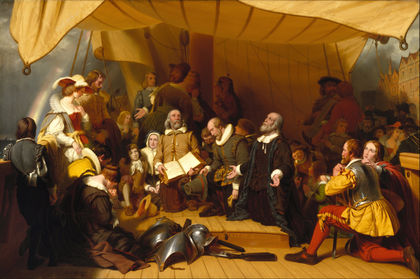
The New World: promised land for the gathering of the twelve tribes
As we trace the history of the reincarnated tribes, we find a very special destiny for the sons of Joseph and the two tribes of Ephraim and Manasseh. These two sons of Joseph, having the highest blessing, the very personal blessing of Jesus Christ in the person of Joseph, having his seed, are the ones called to reverse the sin of the other brothers of the house of Jacob. The other brothers had great sins in their day and unto the present hour.
We also see in Joseph that he married the daughter of an Egyptian priest, and therefore the seed of Egypt and of the ancient Pharaohs, even coming down from Ikhnaton and Nefertiti and the religion of monotheism, is among these particular tribes. They went to the British Isles and became the nucleus of the English-speaking people in Britain, America and the world.
It was given to them to carry the cup of the Christ consciousness and to bring the English language all over the world through colonization and through discovery, so that when the teachings of the I AM THAT I AM would be given again to the children of Israel, they would come through the English language, the language chosen because it most nearly reflected the angelic tongue that is the source of the original teaching to the original people of Israel. So it was the destiny, then, of the English-speaking peoples to carry that Christ consciousness to the new world.
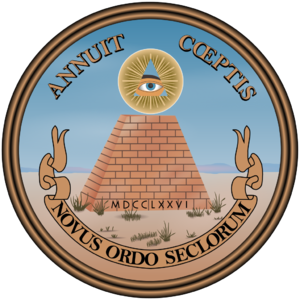
The new world, America, is the land that was promised by the LORD God to the children of Israel. They were told that they would be brought into a new land and would be given a new dispensation. Early records in the history of the nation show that the founding fathers of America knew that they were the people of Israel, that they were the inheritors of this promise and that they had come to a new world to found the New Israel, the New Jerusalem, the new mystery school, the new place of dispensation. We see this symbolized in the Great Seal of the United States, with the All-Seeing Eye of God in the capstone of the pyramid, focalizing the mission of the twelve tribes.
Even in the name, America, there is revealed the origin and destiny of the nation. The letters of the name, when rearranged, spell I AM Race. This is the race of the children of Israel who have accepted their God-reality, who know God as the I AM that was revealed to Moses.[13] They have been called to America as the gathering together of the elect from the four winds,[14] from the four corners of the earth, to bring forth the Christ consciousness and then to take that Christ consciousness to every nation. This is the mission of the Israelites in the United States, founded upon the mystery school of the thirteen—thirteen founding states, Christ and his apostles.
So we see the emigration, vast lines of pilgrims, first from the British Isles, the brothers Manasseh and Ephraim, and then from the tribes of all the different European nations becoming the foundation of the United States.
Tracing the seed of light
We go back, then, to the very history of Jacob and the coming of the twelve tribes to discover our own history. As we understand our history, we understand our blessing. When we study the promises of the prophets and the patriarchs to us, then, when we give our invocations, we are standing upon the rock of Christ, and we have the confirmation of the Word through the flame of the ark of the covenant.
These tribes have a destiny to fulfill. That destiny is to unite under the banner of the I AM THAT I AM—the Presence of God individualized in each one of us in whom there burns the flame of God. Through the Spirit of the living Christ, we are destined to become a major world power.
The twelve tribes of Israel today are not a lineage of twelve tribes by blood, but their descent can best be explained by reincarnation. The seed of Abraham was scattered. They continued to reembody, always carrying that seed, and therefore, they may not be in bodies that resemble the Semite people. They may very well be Chinese or African or Indian or any race. But they have come again.
The seed that they carry is the nucleus of the Christ consciousness. All who have the Christ consciousness are of this seed. And you find that there is a dividing line. You find people of every religion who deny that Flame, that essence, that Spirit, and deny the opportunity for the individual to become that Christ. Others have known from the beginning that they were Christ, they were that Flame, they were that Reality. Others have known it by another name and have intensely resisted the name Christ, but when they understand the true meaning, then they realize that that is the indwelling Presence with whom they, also, have communed.
In the seventh chapter of the Book of Revelation, we read the prophecy of the sealing of the servants of God in their foreheads, twelve thousand from each of the twelve tribes, a total of 144,000. They also appear in chapter 14 as those gathered around the throne of the Lamb, who is Sanat Kumara. And so, in Revelation there is a continuing chronicle of the twelve tribes and of their overcoming of all that is revealed.
Our destiny as the twelve tribes
The twelve tribes of Israel have not maintained a continuous identity over these thousands of years. But our great victory lies in the fact that the identity is in the Inner Flame; no one can take from us the flame of light, the Flame of God, the original Word, the memory of the teachings of East and West, the instantaneous rapport with the I AM THAT I AM and the recognition that Christ was not alone in Jesus but that he is in us. When you find people that have that awareness, you are finding the members of the house of Israel and Judah.
The genius of the twelve tribes is in every nation. All of the nations are forcefields for the development of the Christ consciousness through the twelve tribes, and each of the nations of the earth is an opportunity for the lightbearers to master a certain initiation of a certain chakra.
We find today that the twelve tribes have been caught up and lost their identity as the tribes of Israel and have identified themselves now within their many nations. They have not realized that they have put on their nationhood to identify in that nation, to set the example of the lightbearer to the people.
The Ascended Master Saint Patrick has come to help us make contact with the lightbearers of all nations, to alert them to the message, to alert them to the teachings of the ascended masters, to bring them together so that they can form the nucleus for the victory and the salvation of earth. Until we make this contact, identify our brotherhood, identify our community, we do not sense our strength.
He has said:
I AM the defender of the Woman in this age. I come, then, to secure a place for her children—children of the Mother who have come out of the land of Israel so long ago that they have forgotten their source and their common origin as the seed of Abraham, of David and of Christ, the Messiah of all.
I come, then, to deliver the mandate of truth, and it is this, that the children of the light must be one, that all who have gone forth out of the nucleus of the sacred fire of Jerusalem to the four corners of the earth now are called to be sons and daughters of God. And yet they remain as prisoners of their respective nations—prisoners in the sense that they are bound by certain customs and laws and political and religious ideologies, whereby they have forgotten the one true law of the I AM THAT I AM.
I center, then, the energies of the fiery core of my being here in the heart of the city, the New Jerusalem, and I place the magnet of my devotion to the Mother for the calling in of the rays of the house of the LORD, the rays of Ikhnaton, who saw the one God and the people of God as one, the rays that will call back the one hundred and forty-four thousand flames of the twelve tribes of Israel....
All of this warfare and this division that has been created as the divide-and-conquer tactic of the fallen ones, even midst the brethren of Ireland and of the British Commonwealth of Nations and throughout Europe and the Eastern countries, all of this is to this one purpose, children of the Light—now understand it is to keep the children of Israel separate and apart in the last days.
For in every nation there are lightbearers. But the fallen ones and those who have never elected to be one with the light of God, these live also among these nations. And the children of God, instead of identifying with the life and the Body and the Blood of Christ, have begun to identify themselves as members of these nations. And therefore, they see their national loyalties as greater than their loyalty to the one purpose of the Ancient of Days, Sanat Kumara, which was to keep the flame of life for the evolutions of this earth.
See, then, that you understand that for the defense of the karma and the dharma of the people among whom you have embodied, you must call yourself an American, an Italian, a Chinese or a Russian, but for the purposes of the salvation of earth, you must understand yourselves as the deliverers of the nations.
The cutting free of the nations by the action of your sword of life is your mission and your goal. It is to free the nations to behold within themselves, and not to come under, then, the boot and the darkness of those who proclaim a one-world government and yet do it not in the name of Christ, but in the name of a scientific humanism.
They do err, and their divide-and-conquer tactics have taken a new course in this age. It is to play upon the reality of the inner understanding of the people of God that indeed the earth is one, and to carry that understanding into a perversion whereby the karma and the dharma of the people of the nations is destroyed as they are forced to come into a totalitarian system whereby they are divested of their natural genius and their calling from the mansions of the Father’s house....
I am of the house of Israel! I am of one of the twelve tribes! I come to return the tribes to the one God! I come to rescue all who have gone out of the way! I come as the instrument of the Cosmic Virgin to support the work of the World Mother and her emissaries in this age.[15]
See also
Sources
Mark L. Prophet and Elizabeth Clare Prophet, The Path of Brotherhood, pp. 123–50.
- ↑ James 2:23.
- ↑ Gen. 12:2.
- ↑ Gen. 15:5.
- ↑ Gen. 15:12–16.
- ↑ Gen. 26:2–5.
- ↑ Gen. 32:24–28.
- ↑ Heb. 8:12.
- ↑ 1 Sam. 8:5.
- ↑ Jer. 4:6.
- ↑ Jer. 32:35.
- ↑ The essence of the original teaching of Moses and Sanat Kumara was kept by the Essene communities, who were only a small minority in the Holy Land. Jesus’ parents were part of this community, which provided the spiritual cradle for Jesus’ incarnation. It is believed by many scholars that the early Christian community grew out of the Essene community.
- ↑ See, for example, Raymond Capt, Jacob’s Pillar (Thousand Oaks, Calif.: Artisan Sales, 1977); Colonel J. C. Gawler, Dan: Pioneer of Israel (Thousand Oaks, Calif.: Artisan Sales, 1984).
- ↑ Exod.3:14.
- ↑ Matt. 24:31; Mark 13:27.
- ↑ Saint Patrick, April 3, 1977.
